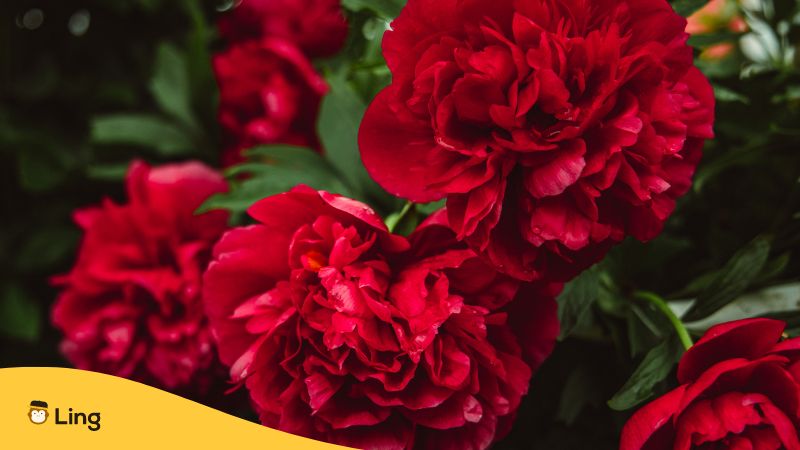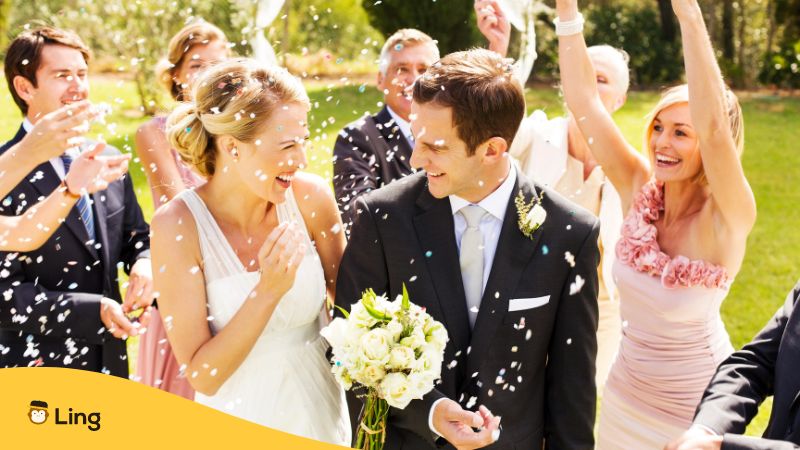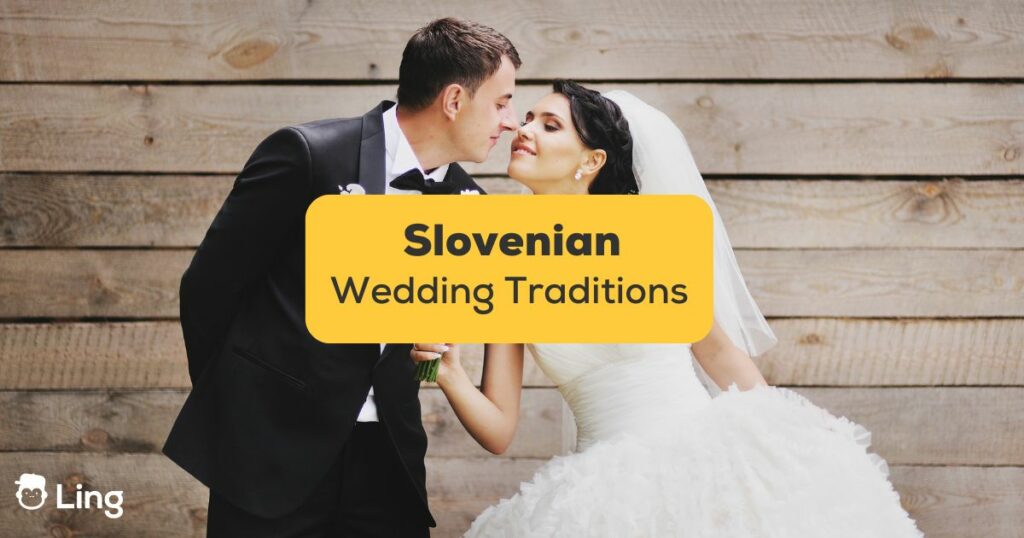I don’t know about you, but weddings are one of my favorite events to attend. A free party where you also get to celebrate the love of someone close to you? Sign me up!
In Slovenia, weddings are a pretty big deal. Some people like to keep it small, while others will go all out and make their special day really huge. In this post, we’ll go through the most common and interesting Slovenian wedding traditions and some useful Slovenian vocabulary!
Table Of Contents
Most Common Slovenian Wedding Traditions
Slovenia is a place that likes to uphold traditions in marriage ceremonies. They give focus to cultural heritage, strong family connections, and the significance of marriage. Let’s take a look at some important Slovenian wedding traditions!
Pre Wedding Games
Slovenians love to do bachelor and bachelorette parties. A bachelorette party is called a dekliščina, and a bachelor party is called a fantovščina. They’re pretty similar to those in many other European countries but some like to include unique Slovenian traditions and activities.
At a fantovščina, the groom and his friends spend the days bonding over activities, followed by a night out in the town or at a pub, drinking and playing games. Sometimes, friends of the groom may play light-hearted pranks, like dressing him up in a funny costume or setting up challenges for him to complete. Some people like to do outdoor activities, depending on what their preferences are.
At a dekliščina, the girls sometimes like to focus on relaxation and pampering. A spa day or a wine-tasting tour are popular. If they’re a bit on the wild side, the bride and her closest friends will go out, making sure the bride-to-be is dressed up to show everyone that she is getting married. They might also do fun games and challenges, while drinking out on the town.
Something Old, New, Borrowed, And Blue
This is a beloved tradition that originally comes from England, but has found a special place in Slovenian weddings as well. Each of these elements is something that the Slovenian brides wear, and they’re supposed to hold a symbolic meaning for each bride.
Something old is worn to represent the bride’s connection to her past. This can be anything, like a piece of old family jewelry.
Something new symbolizes hope and optimism for the future. Ideally, this would be a gift that she has recently received.
Something borrowed means shared happiness. A close friend who is already married should lend the bride something for her wedding day, passing on good luck and marital bliss!
And lastly, something blue, because this represents purity, love, and fidelity. It can be just a small accessory, adding color and meaning to the bride’s outfit.

The Red Carnation
In some particular weddings, you’re likely to see a red carnation. It holds deep cultural and symbolic meaning in Slovenian tradition, representing love and passion.
A significant wedding tradition for Slovenian women is that their veil is removed, which symbolizes their transition to married life. This is followed by the pinning of a red carnation flower in the bride’s hair, and the groom replaces his white boutonnière with a red carnation. Other than the red carnation in her hair, a typical Slovenian bride wears a traditional white dress.
This tradition isn’t just decorative—it’s deeply tied to Slovenian culture, reflecting how love, marriage, and family are cherished in their society!
The Bride’s Handover To The Groom
In rural Slovenia, before the groom can take his bride, there’s a fun tradition where he’s put up to a bunch of lighthearted challenges.
So, when the groom arrives at the bride’s home to pick her up, her father can ask him certain questions like: “What size shoes does the bride wear?” or “How many steps lead to her room?” If he answers correctly, this means that he knows her well and loves her!
Then, the groom’s practical skills are put to the test with tasks like hammering nails, chopping wood, or peeling potatoes. These funny games are meant to show that he’s ready for marriage.
To make things even funnier, sometimes a fake bride, like a grandmother or a young sibling in a wedding dress, is presented to test his commitment.
At the end, he has to sweep the threshold of the house, to make sure his bride’s dress will be kept clean and also to show his care and attention.
The Šranga Tradition
Šranga is a fun tradition where local boys block the groom’s path after he has gotten to his bride. To get through, he has to pay a ransom or do some tasks to show he’s up to the job. The groom’s best man usually helps him out.
The Ceremony
The wedding ceremony itself usually takes place in a church. However, in Slovenia, a church wedding does not have legal standing on its own, so couples typically have a civil ceremony beforehand. Still, the church ceremony has spiritual and cultural importance.
In Slovenia, they often play Mendelssohn’s ‘Wedding March’ during the ceremony. However, sometimes they may play some Slovenian music for a touch of nostalgia and making the ceremony meaningful and memorable for the couple and their families.
It’s customary for the bride and groom to walk into the church together, rather than the bride walking down the aisle with her father, as is common in America.
After the church ceremony, the wedding party usually goes to a nearby restaurant for the reception. This part of the celebration includes eating Slovenian food, drinking, and dancing, which is all very typical for Slovenian weddings.
Tossing Rice
After the newlyweds leave the ceremony, guests sometimes throw rice at them. This symbolizes fertility and prosperity, wishing the couple many children and a fruitful life. For a fun, modern twist, people in Slovenia will use flower petals or soap bubbles!
Bouquet And Garter Toss
In the past, single women would tear pieces from the bride’s dress for good luck. Now, this has turned into the tradition of tossing the bridal bouquet. Single women try to catch it, with the belief that the one who catches it will be the next to marry. The groom also tosses the bride’s garter to the single men.
Cutting The Cake
Something that a lot of couples like to do is to cut the wedding cake together. It’s a special moment that shows the couple working together for the first time as newlyweds. Afterward, they often share sweets or small gifts with the guests.

How Do You Say Wedding In Slovenian?
The Slovenian word for a wedding is poroka. The verb for ‘to marry’ is poročiti se.
Slovenian Vocabulary Related To Weddings
Are you about to attend a wedding in Slovenia? Or are you maybe the one getting married there? Here’s some key Slovenian wedding-related vocabulary to enrich your experience.
And if you’re looking to doing more than just small talk with the other guests after the ceremony, think about downloading the Ling app, which will be your guide on your path to learning Slovenian fluently.
| English | Slovenian |
|---|---|
| Bride | Nevesta |
| Groom | Ženin |
| Ceremony | Ceremonija |
| Reception | Sprejem |
| Vows | Zaobljube |
| Ring | Prstan |
| Marriage | Zakon |
| Bouquet | Šopek |
| Guests | Gostje |
| To toast | Nazdraviti |
| Cake | Torta |
| Dance | Ples |
| Love | Ljubezen |
| Happiness | Sreča |
FAQs About Slovenian Wedding Traditions
What Do You Need To Get Married In Slovenia?
If you’re thinking of using the beautiful country of Slovenia as your wedding destination, there are some things you need to bring with you and some requirements that you’ll need to meet:
- Both partners must be at least 18 years old or have parental consent if younger.
- The marriage must be registered at a Slovenian Marriage Registry Office, with the civil ceremony being legally binding.
- Foreigners can marry Slovenian nationals or other foreigners in Slovenia.
- You need to bring your birth certificates, proof of single status, and, if need be, divorce papers or death certificates of previous spouses.
- For foreigners, a Free to Marry Certificate from their embassy may be required.
- Same-sex couples can get married under Slovenian law since 2017, and the marriages are registered as civil partnerships.
How Much Does It Cost To Get Married In Slovenia?
The cost of getting married in Slovenia depends on what kind of ceremony you want to have and where. All in all, a couple will spend somewhere between €10,000 and €18,000 for a wedding for up to 50 guests.
For a civil ceremony at a registry office (Občina), you’ll need to pay for administrative costs, which can be slightly different between each municipality. Here, you can expect the costs to go up with rental fees for hotels, photographers, catering, decorations, etc. If you want to have a religious ceremony, then the church or religious institution will require some fees.
How Many Marriages End In Divorce In Slovenia?
In 2022, out of the total number of marriages that took place, which was 6,768, the number of couples that got divorced was 2,149! This means that about 31.7% of marriages ended in divorce in Slovenia during that year.

Can You Hear Wedding Bells?
At the end of the day, what makes Slovenian weddings so special is how they mix together all of these cherished traditions with heartfelt moments of joy and celebration. Each tradition reflects a deep connection to Slovenian families, culture, and the future.
Slovenian weddings are about creating unforgettable memories surrounded by loved ones, where every detail symbolizes the start of a beautiful journey of two soul mates.



































































